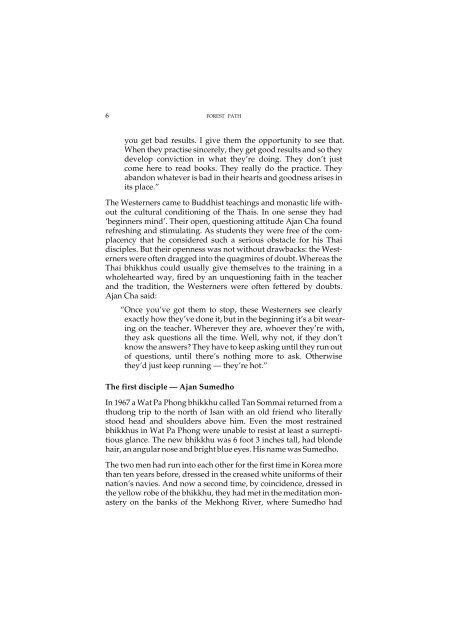Forest Path - Amaravati Buddhist Monastery
Forest Path - Amaravati Buddhist Monastery
Forest Path - Amaravati Buddhist Monastery
You also want an ePaper? Increase the reach of your titles
YUMPU automatically turns print PDFs into web optimized ePapers that Google loves.
6 forest path<br />
you get bad results. I give them the opportunity to see that.<br />
When they practise sincerely, they get good results and so they<br />
develop conviction in what they’re doing. They don’t just<br />
come here to read books. They really do the practice. They<br />
abandon whatever is bad in their hearts and goodness arises in<br />
its place.”<br />
The Westerners came to <strong>Buddhist</strong> teachings and monastic life without<br />
the cultural conditioning of the Thais. In one sense they had<br />
‘beginners mind’. Their open, questioning attitude Ajan Cha found<br />
refreshing and stimulating. As students they were free of the complacency<br />
that he considered such a serious obstacle for his Thai<br />
disciples. But their openness was not without drawbacks: the Westerners<br />
were often dragged into the quagmires of doubt. Whereas the<br />
Thai bhikkhus could usually give themselves to the training in a<br />
wholehearted way, fired by an unquestioning faith in the teacher<br />
and the tradition, the Westerners were often fettered by doubts.<br />
Ajan Cha said:<br />
“Once you’ve got them to stop, these Westerners see clearly<br />
exactly how they’ve done it, but in the beginning it’s a bit wearing<br />
on the teacher. Wherever they are, whoever they’re with,<br />
they ask questions all the time. Well, why not, if they don’t<br />
know the answers? They have to keep asking until they run out<br />
of questions, until there’s nothing more to ask. Otherwise<br />
they’d just keep running — they’re hot.”<br />
The first disciple — Ajan Sumedho<br />
In 1967 a Wat Pa Phong bhikkhu called Tan Sommai returned from a<br />
thudong trip to the north of Isan with an old friend who literally<br />
stood head and shoulders above him. Even the most restrained<br />
bhikkhus in Wat Pa Phong were unable to resist at least a surreptitious<br />
glance. The new bhikkhu was 6 foot 3 inches tall, had blonde<br />
hair, an angular nose and bright blue eyes. His name was Sumedho.<br />
The two men had run into each other for the first time in Korea more<br />
than ten years before, dressed in the creased white uniforms of their<br />
nation’s navies. And now a second time, by coincidence, dressed in<br />
the yellow robe of the bhikkhu, they had met in the meditation monastery<br />
on the banks of the Mekhong River, where Sumedho had

















